Pentatonics Workbook
Major/Relative Minor Pairs Studies
The major and relative minor pentatonic scale pairs share the same five tones. Here’s a tune which will help you learn to recognize and find the notes quickly and surely.
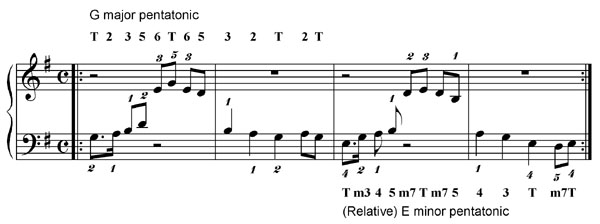
|
MajminOOPP_1
|
Use the full-size music in your Workbook for preference.
The stems-up notes are right hand notes and the stems-down notes are left hand notes.
Left hand finger 2 goes on the tonic (name-note) of the major pentatonic scale and the hands spread out over the pentatonic scale notes from there, four notes each.
The MMYT video shows the pattern played in G, then in C.
Learn the pattern in G using the music and video and then transpose by shape to C (RH 2 on C).
Next, there is a practice-speed MidiPiano performance showing the
pattern played in all the pairs of scales in the Major/Relative Minor Pairs MS section of your Workbook,
The long tonic note at the start of each pattern should give you enough time to find the note and get ready to play along with the performance. Otherwise, you can just watch, hum along, and try to see the keys that will be played in advance.
The fingering given works for all keys, but you must be prepared to play well up the keys (towards the back of them).
Sing along as you play! You do not have to be able to sing in tune – you are familiarising yourself with the pentatonic scales and getting a feel for the relative size of the up/down steps.
The scales single-handed in pairs
Here is a more advanced study for getting to know the major/relative minor pairs of pentatonic scales. Your aim is to be able to transpose this study into any key – starting on any major tonic (T).
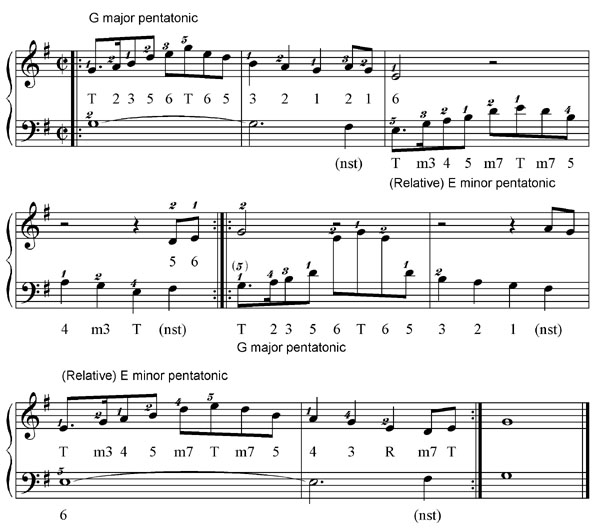
Watch the on-page MidiPiano video and take time to understand the pattern.

One non-scale tone (nst) - Fí - is used to join the major/minor patterns. This is not a pentatonic scale tone.
The second video of this pattern plays the pattern through in G, as in the music, then in D/Bm (one black key), Eë/Cm (two black keys) and E/Cím (three black keys).
As you move into the black keys, fingering becomes more difficult. Don’t worry about being tidy – getting the notes out is what counts. Improvisers often use very unorthodox fingering.
This is the MIDI file in your download, so you can control the speed in MidiPiano on your desktop and play along.
The two studies in this module are primarily about finding the pentatonic scale tones, but any work with the pentatonic scales shades into aural (play-by-ear) practise.
Listen for pentatonic melodies in your favourite popular styles music. With their reduced, five-tone 'palate', the pentatonic scales are a great way to practice 'seeing' the music you hear - and so being able to play it by ear.
|
Fugue Number One
|
Fugue Number Two
|
Study notes
Text
|
OUT NOW! |
THE MUSICARTA BEAT & RHYTHM WORKBOOK At last! An effective approach to keyboard rhythm & syncopation skills. Learn more! |
ONLY $24.95! |
|
THE MUSICARTA PENTATONICS WORKBOOK video course Home/Index pages The Pentatonic Scales
Practice Patterns
Melody Work and
Playing by Ear
Pentatonic Riffs
and Diaries - Minor Pentatonic Major Pentatonic
Chromatic Minor
Chromatic Major
Pre-video Pages
Pentatonics videos
Archive Pages
|
The MusicartaA methodical approach to keyboard syncopation for
|
PUBLICATIONS
exciting keyboard
creativity courses
CHORDS 101
WORKBOOK

~HANON~
video course

Musicarta
Patreon
PENTATONICS
WORKBOOK
video course

Creative Keyboard
video course

BEAT AND RHYTHM
WORKBOOK
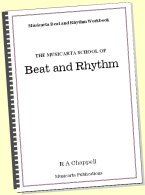
- Volume 1 -

12-BAR PIANO
STYLES WORKBOOK
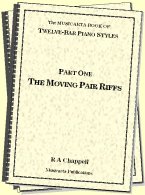
MUSICARTA MODES
WORKBOOK
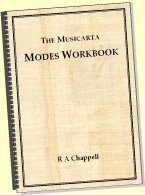
PIANO STYLE
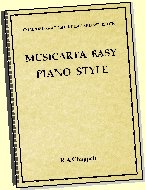
CANON PROJECT
video course

VARIATIONS
video course
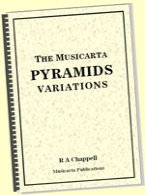

- Piano Solo -
video course

- Piano Solo -


YouTube playlists





 THE LOGO
THE LOGO
